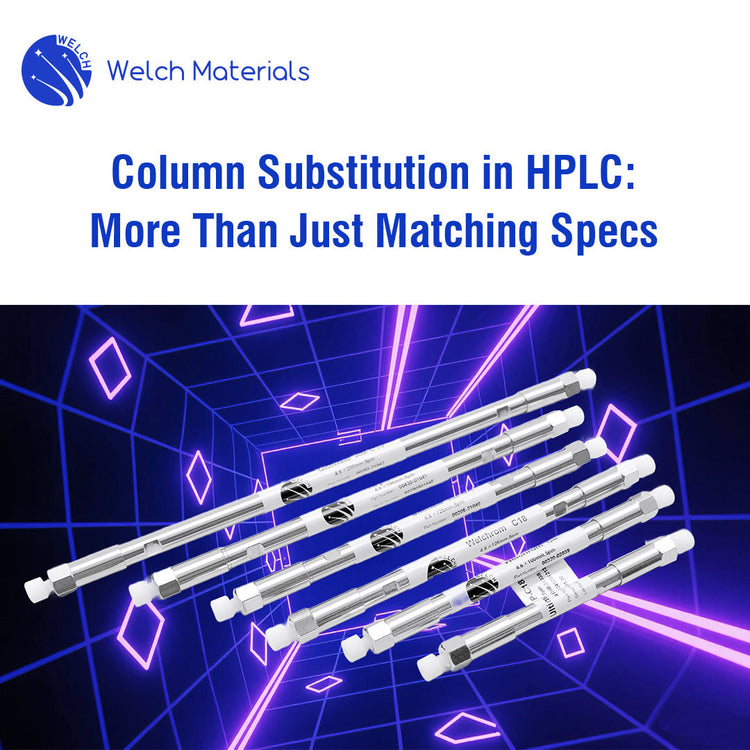Previous article:
Welch Columns Successfully Replace Well-know Equivalents After Tariff Hikes

Introduction
When considering HPLC column replacements, most users focus first on substrate type (silica or polymer), particle structure (fully porous or superficially porous), bonded phase (C18, phenyl, etc.), and column dimensions (length and inner diameter). Next, attention turns to process features such as endcapping or special functional modifications. Naturally, parameters like pH stability and maximum operating temperature are also to be considered.
With all these factors in mind, it’s possible to identify a suitable replacement column—and this is precisely the foundation for manufacturers’ cross reference tables.
| Agilent | Waters | Phenomenex | Welch |
|---|---|---|---|
| ZORBAX RRHT series | Xbridge BEH series | Gemini-NX series | Xtimate series |
| Poroshell 120 series | CORTECS series | Kinetex series | Boltimate series |
| ZORBAX RRHD series | CORTECS series | Luna Omega series | UHPLC series |
| XDB-C18 | Sunfire C18 | Columbus C18 | Ultisil XB-C18 |
| TC-C18 (2) | Atlantis T3 | Aqua C18 | Ultisil AQ-C18 |
| ZORBAX SB-C18 | HSS C18 SB | N/A | Ultisil LP-C18 |
| Pursuit PFP | HSS PFP | Luna PFP (2) | Ultisil PFP |
| ZORBAX Eclipse PAH | PAH C18 | Venusil PAH | Ultisil PAH |
| Bio SEC | Protein BEH SEC | BioSep-SEC-S2000 | Xtimate Bio SEC-120 |
| BioSep-SEC-S3000 | Xtimate Bio SEC-300 | ||
| AdvanceBio HIC | Protein-Pak Hi Res HIC | N/A | Advanchrom HIC-Butyl |
An example of Welch cross reference table
Yet in practice, only trial runs can truly verify whether the substituted column meets project needs: retention of target peaks, peak shape, and impurity resolution.
In the past three months alone, Welch columns have successfully replaced imported brands in over 100 cases. We’ve found that following the above approach yields a high probability of success. But here’s an interesting observation: sometimes a non-equivalent column actually performs better. How so? Let’s look at a few cases.
Case 1
Customer:
“We’ve been using an SB-C18 column for a related substances testing. Your cross reference says Ultisil LP-C18 is the equivalent, right?”
Welch:
“That’s correct in terms of correspondence. But could you share more about your sample properties, chromatographic conditions, and current results? We may have an even better option.”
Customer:
“The main compound is basic, mobile phase pH is 8.0, and the column temperature is 40 °C. Here’s the chromatogram:”

Welch:
“From the chromatogram, I see the main peak shape isn’t great (tailing factor 1.63), and the resolution between the two impurity peaks after it is poor (Rs = 1.03). The SB-C18 uses non-endcapped silica, leaving many free silanols (negatively charged) that interact with your basic analyte (positively charged when ionized). That’s likely why the peak tails. I’d recommend a dual endcapped column. Also, since your conditions are rather demanding, a hybrid-silica column could be even better. Based on this, I suggest our Xtimate C18.”
Customer (after testing):
“The peak shape is much better (tailing factor 1.07), and the resolution of those two impurity peaks improved dramatically (Rs = 2.04). This is an unexpectedly perfect replacement!”

Case 2
Customer:
“We’re running lidocaine hydrochloride on a Symm C18 column, but the column efficiency drops too fast. Do you have a replacement?”
Welch:
“Let’s look at your chromatographic conditions.”
Mobile phase system:
Phosphate buffer (1.3 mL of 1 mol/L NaH₂PO₄ + 32.5 mL of 0.5 mol/L Na₂HPO₄, diluted to 1000 mL with water) – Acetonitrile (50:50), adjusted to pH 8.0 with phosphoric acid.
Welch:
“Since your mobile phase is strongly alkaline (pH 8.0), that’s already the upper limit of conventional silica columns. I’d recommend a hybrid silica column—our Xtimate C18 (pH 1.0–12.5).”
Customer (after testing):
“The separation with Welch’s column is equivalent, but the number of injections before efficiency loss is three times higher than before!”
Case 3
Customer:
“For our letrozole project, we’re currently using a Tri C18 column (hybrid silica, 120 Å pore size, 20% carbon load). We want a domestic alternative that’s cheaper. As long as resolution is acceptable, the faster the peaks elute, the better.”
Welch:
“Understood. Could you share your chromatographic conditions?”
Mobile phase system:
A: Water
B: Acetonitrile
Welch:
“Your system is quite straightforward, so a conventional silica column should be sufficient. Considering your need for faster elution, I’d recommend a column with a slightly larger pore size and lower carbon load—our Ultisil Plus C18 (130 Å pore size, 10% carbon load). This reduces interactions with the analyte, speeding up separation.”
Customer (after testing):
“That’s exactly what we needed!”
Conclusion
The above cases speak for themselves: column replacement isn’t just about matching packing parameters or sticking to a one-to-one equivalent. Even within C18 columns, selectivity can vary significantly (see The Four Pillars of Welch ODS Columns). In some cases, what begins as a “replacement” can actually become an “optimization.”
At Welch, we focus on comprehensive, multi-dimensional evaluation—considering the specific application, physicochemical properties of the analytes, and the full set of chromatographic conditions. Our goal is not only to ensure compliance but also to enhance analytical efficiency and accuracy, delivering customized solutions tailored to each client’s needs.





